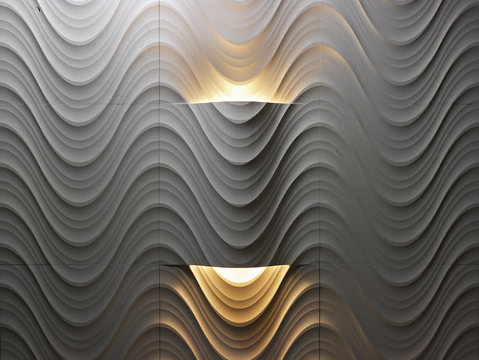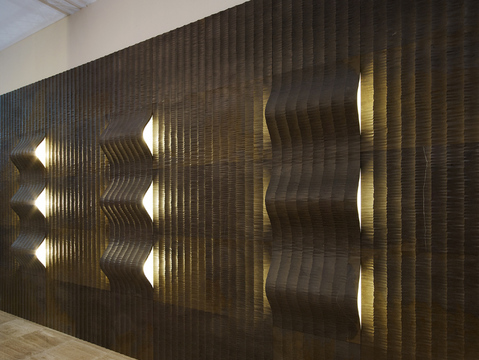Sinuous stone metamorphosis
February 28, 2011“Design is one method of giving form to matter and making it appear as it is and in no other way. Design, like all cultural expressions, shows that matter isn’t bold, if not in the way in which it takes shape and in-forms, and that once it has taken shape and has in-formed, it becomes outstanding (a phenomenon). So matter in design, as in any area of culture, is the way in which forms appear.
Nevertheless, to say that design stands between the material and the immaterial is not completely out of place. There are in fact two ways of seeing and thinking: in a material and a formal way.”
Vilém Flusser, Philosophy of design, Mondadori 2003 (ed. or. 1993), p. 12

Sinuous stone metamorphosis
We create from matter, we meet in matter, sooner or later. In the end, we are a “slave” to the act of transforming our surroundings, accepting it as a positive image of creative formal thought that is articulated through the ideas and visions of figures, contours, bodies, spaces.
Three-dimentional forms, as we know, are never completely free.
It (the “form”) is first a latent and immaterial idea, which is then thought out, manipulated, forced to express itself starting with its own material characteristics, becoming available - as it turns into a “material form” - for creation, for a creative project.
Material forms are, inevitably, connected to their recent and ancient uses. It’s fair to say that the creator always -consciously or unconsciously - draws on teachings from “stable” experiences or vast solutions accumulated over time that define, in the end, the figurative culture of the material.
Forms, images, immaterial visions - as long as they mirror “material things” -inadvertently pass, filter and settle in the mind.
Sooner or later they resurface.
If history is revisited, reconsidered and reassimilated into the theory and contemporary aspects of a creative project, and a personal interpretative contribution results, then the material in question can shine in a new way inside the work of architecture, design and art.
Forty-year-old designer Raffaello Galiotto embraces such a challenge in the fields of architecture, interior design and product design, as can be seen by his prolific re-interpretation of ancient stone and his lengthy experiments undertaken with enthusiasm, creativity and the support of new technologies and computerised machines for Lithos Design, a young company from Valle del Chiampo led by Alberto and Claudio Bevilacqua that is open to dialogue and involved in the exchange of ideas through university research, the culture of design, and the now strongly competitive and globalised markets.
Galiotto’s experiments continue to appear clear, original and in many ways innovative, since five years ago when we were able to appreciate the first prototypes and industrial products of the “Carved stone” collection, a series that created intense debate and interest.
His works is based on research that has evolved in phases – together with the Lithos Design company and multi-company projects such as “Palladio and stone design” (2008) and “The Doge’s Marble” (2009) promoted by Consorzio Marmisti Chiampo - and has focused on an obvious three-dimentional plastic tribute to stone surfaces even also when their final use as a basic, thin stone plate was aimed at covering walls (as with the “Carved stone” collection).
Raffaello Galiotto abandons “two-dimentional reductionism” which dresses itself today in the vests of contemporary minimalism, to consciously give value to the three-dimentional plastics of the material and moves wisely towards possible interpretations and configurational, connective, “moulding” variants of this rocky - monolithic and extensive, variegated and polychromatic - source of stones, marble, granite and travertine.
As a result, in Galiotto’s work, the conventional view of stone surfaces destined for architecture and interior design - marked by the geometry of length, width and planar extentions -goes from a two-dimentional figurative representation (that defines volume or covers the inside of spaces like a homogenous coplanar “skin”) to a surface strengthened by a strong and exhuberant tribute to plastic and often by a sinuous and lithe progressional flow.
We mentioned the synergetic relationship between the creativity of the designer and the technological know-how of a company, by now gifted with advansed and sophisticated machines without which high quality precise results would, undoubtedly, not be possible. Here, we are talking about machines specifically made to aid Lithos Design in its research and advanced production objectives.
Between the creative mind of designer Raffaello Galiotto and the machines is the new frontier for three-dimentional viewing and modelling.
Advanced software-assisted design shows how computers are no longer simple working tools with regards to the creation phase. The enormous capacity of computer programs to calculate and represent demonstrate that they are a contextual element and co-generator of ideas and even of complex sketches of forms like those sought by Raffaello Galiotto who “translates” onto stone his experience and extensive research on pliable material such as plastic or metal necessary to create complex molds.
The new world of prefiguration which uses information technology interfacing has created new energy for unconventional experiments to take place on geometric figures (and their extentions) making it possible to test a form (or several forms) inside actions, retroactions, visualisations and variants in real time.
Raffaello Galiotto is one of the first interpreters of this new artistic scene to direct creative energy to designing original stone surfaces that, progressively, evolve into structures that are heavily mono-materialistic with complex configurations that are fluent and innovative – as with the “Stone walls” collection. He moves to tackle - soon, I hope - stereotomic structures capable of transporting his research on interior design (or external spaces) to that of contemporary architecture based on stone which has been strongly revaluated and linguistically discussed for at least two decades.

Palladio e il design litico
To celebrate the quincentenary of the birth of this great architect the marble craftsmen of the Consorzio of Chiampo (CMC) gave me the honour of trying to find an idea that could bring to light some aspects, perhaps not well known, of Palladio and show the high level of professionalism of the workmanship in the Chiampo area connected with working with stone.
What is the relationship between Palladio and stone design?
To try to give an answer to this question I did a research. In what I would say a surprising way emerged a recurrent geometric profile from the comparative study of the works and drawings.
I thereafter designed the objects of this exhibition on this profile and even if in a flattened or simplified shape one can find that it is always present.
The projects, born on paper as sketches, were then elaborated on in detail by my studio with sophisticated 3D programmes after which, using the best available technology, they were made in marble, stone and granite by the expert marble craftsmen of the CMC.
I Marmi del Doge
“The conversation between Kublai Kan and Marco Polo in “Le Città Invisibili” by Italo Calvino comes to mind: “Why do you speak to me about stones?” says Kublai Kan, “I only care about the arch”. Polo replies: “Without stones there is no arch”. To put it in another way: without stones, Venice would not be.”
“Interpreting the hidden suggestions in the marble of the Palazzo Ducale, and working with the best kind of marble himself, Galiotto - and the marble workers of the Valle del Chiampo - have created contemporary objects and environments of very high artistic quality (but that are still functional and reproducible) aimed at hospitality and welcome. If, in their deepest sense, these objects and these environments carry a hidden memory of the Palazzo Ducale, their “destination” echoes an historic role - very much present today - of Venice as a city of welcoming, a “door” between the East and the West, a place of meeting and of dialogue between people, cultures, religions”.
Massimo Cacciari
Mayor of Venice
Raffaello Galiotto
He studied at the Accademia di Belle Arti in Venice, during his training he entered the world of industry where he started collaborating on design project which soon led to business relationship that eventually resulted in him being able to set up his own activity and to open his industrial design practice in 1993.
At first he worked for companies in the furniture industry, thus becoming highly experienced in the design of extremely popular, large, plastic products.
He expanded his horizons by applying his knowledge to various other sectors, from outdoor and indoor furniture, to kitchens, to items for pets, to stone products and by so doing encountered and learnt about materials and technologies used for different types of production.
In the stone sector, in particular, and with the close collaboration of firms, he creates innovative products with new types of surfaces, gaining national and international awards. Collaborates with prestigious Italian universities and holds lectures and conferences with delegations of international architects.
In recent years, he projected important events of stone design and in collaboration with the CMC (Consorzio Marmisti Chiampo) conducted two important events: “Palladio e il design litico” and “I Marmi del Doge“ exposed at Marmomacc Verona and now in several european cities.
back to top print
Post-it
ISSN 2239-6063
edited by
Alfonso Acocella
redazione materialdesign@unife.it





